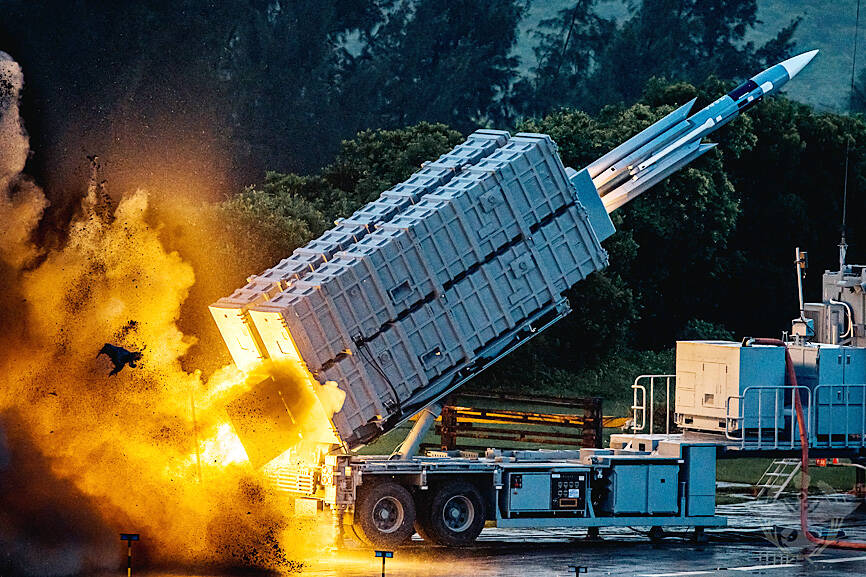More than 1,000 domestically produced missiles are expected to be delivered next year and a production plan would be adjusted according to the nation’s needs, defense sources said on Saturday.
The Chungshan Institute of Science and Technology (CSIST) is manufacturing the missiles as part of its Sea-Air Combat Power Improvement Plan.
The plan has been allocated a special budget of NT$228.9 billion (US$7.4 billion) from last year to 2026, with this year’s budget being the highest at NT$60.9 billion, one of the sources said.

Photo: EPA-EFE / the Ministry of National Defense
Last year’s budget was NT$46.3 billion, while the budget would be NT$47.4 billion next year, NT$45.8 billion in 2025 and NT$28.3 in 2026, the source said.
The allocation is expected to result in the largest delivery of missiles next year to address developments in the Taiwan Strait, they said.
This year’s missile production is estimated to be close to 1,000, the source said.
The overall spending plan includes two phases of mobile coastal-defense cruise missiles, an air-defense system, an uncrewed aerial vehicle (UAV) system, the Wan Chien air-to-ground missile system, the Hsiung Feng II-E (HF-2E) land attack cruise missile system, and two phases of high-performance naval vessels, as well as weapons systems for coast guard vessels, the source said.
The manufacture of the Wan Chien air-to-ground missile system is to be completed next year, while the UAV and the HF-2E missile systems would be ready in 2025, the source said.
Asked whether the government would unveil a second purchase package or raise the annual defense budget to boost weapons manufacturing, a high-ranking official said on condition of anonymity that the government would follow the most suitable plan based on its predictions of how the cross-strait situation would develop.
With the delivery of sea and air missiles, the military would gradually adjust its air-defense, anti-ship and naval units, while retiring old missile systems, the official said.
Countries such as the US, Japan and China are paying attention to the combat power of Taiwan’s missile forces, they said, adding that the military would unveil the outcomes of its improvement plan soon.
In other developments, a source close to the military yesterday said that the army is customizing reconnaissance drones made by the CSIST to give them combat capabilities.
Some of the UAVs have been equipped with a laser targeting system that can lock on to targets and transmit the coordinates to a military base, the source said.
Others would be equipped with weapons systems to give them the capability to retaliate against possible to attacks while on reconnaissance missions, the source said.
The drones being refitted are among the 50 rotor-based models ordered from the CSIST for NT$779.98 million. Fourteen were delivered last year and 36 this year.
The UAV was unveiled at a military demonstration in January. The army at the time said soldiers need only two weeks of training to operate the drones, with refresher courses scheduled every two years.
The drone is 180cm long, 39cm wide and 55.7cm high. It has a top speed of 64kph and can climb to 1,500m.
Weighing 25kg, it can withstand level 6 winds on the Beaufort Wind Scale and can fly for 60 minutes on a single charge.

Taiwan is gearing up to celebrate the New Year at events across the country, headlined by the annual countdown and Taipei 101 fireworks display at midnight. Many of the events are to be livesteamed online. See below for lineups and links: Taipei Taipei’s New Year’s Party 2026 is to begin at 7pm and run until 1am, with the theme “Sailing to the Future.” South Korean girl group KARA is headlining the concert at Taipei City Hall Plaza, with additional performances by Amber An (安心亞), Nick Chou (周湯豪), hip-hop trio Nine One One (玖壹壹), Bii (畢書盡), girl group Genblue (幻藍小熊) and more. The festivities are to

Auckland rang in 2026 with a downtown fireworks display launched from New Zealand’s tallest structure, Sky Tower, making it the first major city to greet the new year at a celebration dampened by rain, while crowds in Taipei braved the elements to watch Taipei 101’s display. South Pacific countries are the first to bid farewell to 2025. Clocks struck midnight in Auckland, with a population of 1.7 million, 18 hours before the famous ball was to drop in New York’s Times Square. The five-minute display involved 3,500 fireworks launched from the 240m Sky Tower. Smaller community events were canceled across New Zealand’s

The Ministry of Foreign Affairs (MOFA) yesterday said it is closely monitoring developments in Venezuela, and would continue to cooperate with democratic allies and work together for regional and global security, stability, and prosperity. The remarks came after the US on Saturday launched a series of airstrikes in Venezuela and kidnapped Venezuelan President Nicolas Maduro, who was later flown to New York along with his wife. The pair face US charges related to drug trafficking and alleged cooperation with gangs designated as terrorist organizations. Maduro has denied the allegations. The ministry said that it is closely monitoring the political and economic situation

‘SLICING METHOD’: In the event of a blockade, the China Coast Guard would intercept Taiwanese ships while its navy would seek to deter foreign intervention China’s military drills around Taiwan this week signaled potential strategies to cut the nation off from energy supplies and foreign military assistance, a US think tank report said. The Chinese People’s Liberation Army (PLA) conducted what it called “Justice Mission 2025” exercises from Monday to Tuesday in five maritime zones and airspace around Taiwan, calling them a warning to “Taiwanese independence” forces. In a report released on Wednesday, the Institute for the Study of War said the exercises effectively simulated blocking shipping routes to major port cities, including Kaohsiung, Keelung and Hualien. Taiwan would be highly vulnerable under such a blockade, because it